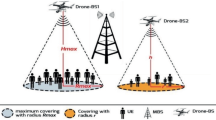Abstract
One of the most important issues in wireless networks is the proper coverage of users as well as providing quality of service (QoS). The fifth generation of mobile networks is moving towards higher QoS with higher data rates, but this higher rate reduces the coverage of drone base stations (DBSs). The existence of natural and abnormal events around the world makes user coverage difficult on the mobile network. One solution to this problem is to use the unmanned aerial vehicle (UAV) as a mobile DBS. In the mobile network, the problem of optimizing DBSs positioning is the most important issue for covering users and guaranteeing the QoS. In this paper, finding the proper location of DBSs is modeled as a \({\varvec{P}}\)-median optimization problem, where \({\varvec{P}}\) is the number of DBSs available to cover users. Since this \({\varvec{P}}\)-median model requires a set of specific nominee points to select the location of DBSs, two methods are proposed to introduce these points. The optimal value of P for each method is also obtained by the heuristic algorithm. Finally, by solving the optimization problem, the optimal locations of DBSs are specified and the two methods are numerically evaluated.




Similar content being viewed by others
References
Kouhdaragh, V., Verde, F., Gelli, G., & Abouei, J. (2020). On the application of machine learning to the design of UAV-based 5G radio access networks. Electronics, 9(4), 689.
Hajiakhondi-Meybodi, Z., Mohammadi, A., & Abouei, J. (2021). Deep reinforcement learning for trustworthy and time-varying connection scheduling in a coupled uav-based femtocaching architecture. IEEE Access, 9, 32263–32281.
A. Akarsu, T. Girici, Resilient Deployment of Drone Base Stations, In Proc. International Symposium on Networks, Computers and Communications, 2019.
Sun, X., Ansari, N., & Fierro, R. (2020). Jointly optimized 3D drone mounted base station deployment and user association in drone assisted mobile access networks. IEEE Transactions on Vehicular Technology, 69(2), 2195–2203.
E. Kalantari, M. Z. Shakir, H. Yanikomeroglu, and A. Yongacoglu, Backhaul-aware robust 3D drone placement in 5G+ wireless networks, In Proceedings IEEE International Conference on Communication Work, pp. 109–114, 2017.
Taghavi, M., & Abouei, J. (2019). Two-dimensional drone base station placement in cellular networks using MINLP model. International Journal of Electronics and Telecommunications, 65(4), 701–706.
Bor-Yaliniz, I., Szyszkowicz, S. S., & Yanikomeroglu, H. (2018). Environment-aware drone-base-station placements in modern metropolitans. IEEE Wireless Communications Letters, 7(3), 372–372.
R. I. Bor-Yaliniz, A. El-Keyi, and H. Yanikomeroglu, Efficient 3-D placement of an aerial base station in next generation cellular networks, In Proceedings of IEEE International Conference on Communication, pp. 1–5, 2016.
Yang, P., Cao, X., Yin, C., Xiao, Z., Xi, X., & Wu, D. (2017). Proactive drone-cell deployment: overload relief for a cellular network under flash crowd traffic. IEEE Transactions on Intelligent Transportation Systems, 18(10), 2877–2892.
V. Sharma, M. Bennis, and R. Kumar, UAV-assisted heterogeneous networks for capacity enhancement, In Proceedings of IEEE Communication Letter, 20(6), 1207–1210, 2016
Mozaffari, M., Saad, W., Bennis, M., & Debbah, M. (2016). Efficient deployment of multiple unmanned aerial vehicles for optimal wireless coverage. IEEE Communications Letters, 20(8), 1647–1650.
Chen, M., Mozaffari, M., Saad, W., Yin, C., Debbah, M., & Hong, C. S. (2017). Caching in the sky: Proactive deployment of cache-enabled unmanned aerial vehicles for optimized quality-of-experience. IEEE Journal of Selected Areas in Communication, 35(5), 1046–1061.
Sharma, V., Bennis, M., & Kumar, R. (2016). UAV assisted heterogeneous networks for public safety communications. IEEE Communications Letters, 20(6), 329–334.
M. Mozaffari, W. Saad, M. Bennis, and M. Debbah, Optimal transport theory for power-efficient deployment of unmanned aerial vehicles, In Proceedings of IEEE Communications, pp. 1–6, 2016
Al-Hourani, A., Kandeepan, S., & Lardner, S. (2014). Optimal LAP altitude for maximum coverage. IEEE Wireless Communication Letters, 3(6), 569–572.
E. Kalantari, I. Bor-Yaliniz, A. Yongacoglu, and H. Yanikomeroglu, User association and bandwidth allocation for terrestrial and aerial base stations with backhaul considerations, In: Proceedings of IEEE International Symposium on Personal, Indoor and Mobile Radio Communications, pp. 1–6, 2018.
Z. Zhu, L. Li, and W. Zhou, QoS-Aware 3D Deployment of UAV Base Stations, In: Proceedings of International Conference on Wireless Communications and Signal Processing, 2018.
Zhang, L., & Ansari, N. (2019). Optimizing the deployment and throughput of DBSs for uplink communications. IEEE Open Journal of Vehicular Technology, 1, 18–28.
A. Tawfiq, J. Abouei, and K. N. Plataniotis, Cyclic orthogonal codes in CDMA-based asynchronous wireless body area networks, In: Proceedings of IEEE International Conference on Acoustics, Speech and Signal Processing (ICASSP), 2012, pp. 1593–1596.
X. Zhou, S. Durrani, J. Guo, H. Yanikomeroglu, Underlay Drone Cell for Temporary Events: Impact of Drone Height and Aerial Channel Environments, IEEE Internet of Things Journal, 6(2), 2019.
Ergen, M. (2009). Mobile broadband: including WiMAX and LTE. Berlin: Springer Science+Business Media.
T. K. Vu, et al, Joint Path Selection and Rate Allocation Framework for 5G Self-Backhauled mm-wave Networks, IEEE Transactions on Wireless Communications, 19, (2019).
M. Mozaffari, W. Saad, M. Bennis, M. Debbah, Unmanned aerial vehicle with underlaid device-to-device communications: Performance and tradeoffs, IEEE Transactions on Wireless Communications, pp. 3949–3963, 2016
Funding
Not applicable.
Author information
Authors and Affiliations
Corresponding author
Ethics declarations
Conflict of interest
The author declare that they have no conflict of interest.
Additional information
Publisher's Note
Springer Nature remains neutral with regard to jurisdictional claims in published maps and institutional affiliations.
Rights and permissions
About this article
Cite this article
Taghavi, M., Abouei, J. A Mathematical 3D Solution to Efficiently Locate Drones in 5G Wireless Networks. Wireless Pers Commun 122, 1519–1530 (2022). https://doi.org/10.1007/s11277-021-08959-2
Accepted:
Published:
Issue Date:
DOI: https://doi.org/10.1007/s11277-021-08959-2




